New cars are actually very affordable – assuming you don’t buy an expensive one. The problem is that many people don’t buy the affordable ones – the ones you can buy, brand-new, for less than $20,000 and in several cases for about $15,000 or so.
Cars like the Kia Accent sedan I recently test drove (review here) and its rivals, models like the Nissan Versa and Mitsubishi Mirage sedan, the latter available for just over $14,000 brand-new.
And that’s cheap.
It just doesn’t seem like it because inflation has made the number seem big – and because of the other costs you’re forced to pay when you buy any new car.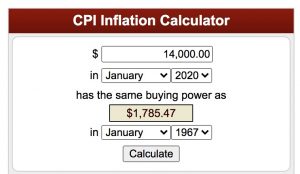
Some of them over and over and over – for as long as you own the car.
First, let’s have a look at that $14k and see what the number really represents . . . in 1967 dollars. Back then, $1,785 had about the same buying power that $14k has today.
And what could you buy back in ’67 with $1,785?
Interestingly enough, you could have bought a brand-new VW Beetle – base trim – and driven away from the dealer with $146 left in your pocket. It stickered for $1,639 – and for that you didn’t get air conditioning or an automatic transmission or power anything at all. You got two doors, glass – and a heater.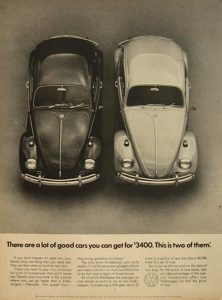
Plus tires.
Cars like the new Accent/Versa/Mirage all come standard with AC and power for pretty much everything; some come standard with cruise control. They can cruise without strain at 75, too – which was approaching the ’67 Beetle’s top speed. And they can be counted on to run without issues for 15-20 years and 150,000-plus miles – which was a lot longer than a a ’67 Beetle would run without a rebuild of its air-cooled engine. Which didn’t cost nothing.
If you take the superior longevity of the modern car into account, it costs less than a ’67 Beetle did over the course of its useful service life.
This in spite of all the air bags and government-imposed cost-adding.
Yet it nonetheless costs a fortune to own a car today vs. what it cost back in ’67. And the reason for that has nothing to do with the car, per se. It has everything to do with the serial costs imposed post-purchase by the government, which end up costing you almost as much as the car itself.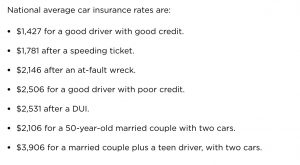
Probably the single biggest cost added is the cost of insurance, which the government forces every car owner to buy. Whatever you think about the morality of forcing people to pay for hypothetical damages they haven’t actually caused, it is inarguable that forcing everyone to buy insurance has made insurance more expensive for everyone. For two reasons.
The first reason is that when the government forces you to buy something, you are going to be forced to pay more for it. Without the power to not buy it, there is no restraint upon the cost of it – so you pay what they say because what choice do you have?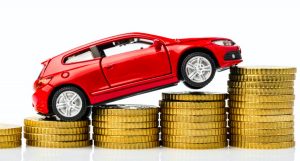
But there is another, subtler reason.
By forcing everyone to buy insurance, the government has incentivized fragile – and expensive to fix – car design. Examples of this include the use of aluminum, easily bent and costly to unbend as well as the use not only of plastic – easily torn or cracked and usually not fixable at all – for front and rear clips that can be “totaled” in what used to be supermarket parking lot scuffs that could be buffed out without fixing anything at all.
Such flimsy design would be avoided if people weren’t forced to pay for it. Put another way, if those who chose to buy such flimsy cars had to pay full freight for the risk they chose to assume but others could chose not to pay for it at all, then such flimsy design would be extremely uncommon rather than ubiquitous – because it would be too expensive to “cover” for those who purchased cars so designed.
In any event, insurance is devastatingly expensive. The average cost of a full-coverage policy is $1,427 per year – for a driver with a “clean” DMV record and a good credit score (yes, they dun you higher for lower credit, irrespective of your record of accidents or tickets). If you have a couple of traffic tickets to your credit you will pay more.
Let’s adjust that for inflation.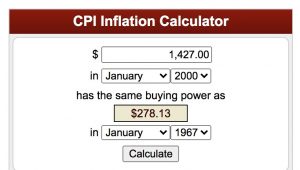
It works out to about $278 in 1967 dollars – a sum equivalent to about 20 percent of the cost when new of an entire 1967 Beetle. Put another way, that $278 in 1967 dollars paid each year for six years – $1,668 – would come to more than the cost of the ’67 Beetle itself ($1,639).
Even if you pay “only” $500 annually for insurance, you’re still paying through the nose. Over a ten-year period, you’re paying $5,000 to be precise – and that’s not a small sum. It amounts to about a third the cost of a new car such as the Hyundai Accent or Nissan Versa or Mitsubishi Mirage mentioned earlier.
Stated another way, that $15k new car actually costs you $20k – and that’s just counting the cost of insurance. If you add the costs added by the government for such things you’re forced to buy if you own a car such as mandatory annual registration renewals and inspections – which have also increased in cost not so much because of inflation but rather because you can’t say no – plus the ongoing taxes many are forced to pay every year as the condition of being allowed to continue owning the car, even if it’s paid off – the total cost ends up being half or more what you paid for the car itself.
And that’s why cars are expensive, even though the cars themselves actually aren’t.
. . . .
Got a question about cars, Libertarian politics – or anything else? Click on the “ask Eric” link and send ’em in!
If you like what you’ve found here please consider supporting EPautos.
We depend on you to keep the wheels turning!
Our donate button is here.
If you prefer not to use PayPal, our mailing address is:
EPautos
721 Hummingbird Lane SE
Copper Hill, VA 24079
PS: Get an EPautos magnet or sticker or coaster in return for a $20 or more one-time donation or a $10 or more monthly recurring donation. (Please be sure to tell us you want a magnet or sticker or coaster – and also, provide an address, so we know where to mail the thing!)
My eBook about car buying (new and used) is also available for your favorite price – free! Click here. If that fails, email me at [email protected] and I will send you a copy directly!












I ended up selling my 2016 Chrysler 300 due to the insurance cost. I didn’t even have payments on it, but it irked me to pay all that insurance especially when I hardly ever drove it (working at home). Now I’m back to driving my 21 year old Honda Accord! It even qualifies for no emissions test since it’s over 20 years old.
The bare-bones Nissan Versa (1.4L, 5sp manual) is like *The best car out there*! Nissans are good cars, except for their CVT, which is a deal breaker. Their engines, 1.4, esp 1.8, 2.5 fours are all excellent, as well as the 3.5 six cylinder. But their CVT is ABSOLUTE JUNK. In the end, I ended up spending more $$ and got a ’14 VW jetta wagon, 2.5L five cyl and 5sp manual. No direct injection, not too much electronics. I think my VW is pretty much the last of the too-much-electronics cars.
Dunno if Nissan still has the manual trans Versa. When I did test drive it, I noticed the back seats did not fold down in order to pass thru to the trunk. (Higher trim models had this). Its funny how with each bare bones model, there’ll be *one thing* that is so simple to already have on the car (feature-wise) that they will leave out on purpose, in order to get you to buy the next-up trim level!
* not-too-much-electronics
The CPI is a rigged number (ie: ex food and energy WTF???)
Jonathan Williams is the go to guy for geeking out on states and he proffers a much higher dollar devaluation % (we mis-name inflation as price increases. It’s technically the weakening of the buying value of the promissory notes in you pocket disguised as money)
http://www.shadowstats.com/
PS Did you say VWs had heaters Eric? I recall those little vents on the floor board blowing tepid damp air in the winter and doing a capital job of warming the frame rails in summer 🙂
Hi Auric!
Believe it or not – and I say this as someone who has owned several old VWs – the heater actually worked well . . . if no one screwed with the tinwork. If the cable-actuated vents worked properly. Remember: It gets cold in Germany and air-cooled engines have the advantage in that regard of warming up faster!
eric, I don’t often see commercials, just if I can’t move to another video quick enough. What I get out of selling vehicles is though, if you can’t put 9 people in it and pull a 15,000 lb trailer it’s really not worth having.
Having said that though, I really would like one of those high top vans that hold 8 made off the old Chevy 3/4 T frame from the 90’s. Damn, they look comfy and have an LS engine, maybe the best engine being made now.
One of the joys of life in New Hampshire is that we don’t have mandatory insurance. As a result, our insurance is cheaper.
When I moved from Texas in 2012, my insurance rep calculated the new police cost, then said, “It looks like it’s only going up a little.”
I thought that was odd, but didn’t say anything. Then she drew in her breath and said, “OH! That’s for a 12 month policy in NH, instead of six months in Texas. You’re going to save a LOT of money!”
Of course, liability insurance above the state minimums is always prudent, and any finance company requires full coverage. It’s still cheaper in NH than in most states.
*policy cost
But the police cost us less here, too. They tend to not shoot people for no good reason.
Kevin, they stick it up your ass. And if you buy a used vehicle, regardless of if it’s beat to hell, Texas determines it’s worth and charges you the requisite taxes. It’s a bit money-maker obviously.
Hi Kevin,
There are still pockets of freedom left; they are in the process of being eliminated. It is intolerable to the ruling elites that the average person have any economic independence as that is the essential nature of independence. People who owe can never be free.
My state also charges excise tax. So the first time you go to transfer and register your new car, you’re paying more than the first payment. This is in addition to our 7% sales tax, which is rolled into the financing. Excise goes down a bit every year, but it’s something to remember when buying something nice, that this bill will be there every year.
Morning, Amy!
We have the same tax on personal property here in Coonman Country (Va). I am still paying about $100 annually on my nearly 20-year-old truck.Some will say that sounds like not much. Times it by the past 12 years and bear in mind the tax was higher when the truck had a higher retail value (the tax is based on that). But let’s assume $100 annually for the sake of discussion; that’s $1,200 – so far – plus the demand I also pay $60 annually to “register” it plus an other $20 annually to “inspect” it… plus all the taxes I paid to title it and when I bought it and every time I put gas in the tank…
And the taxes I’m forced to pay are “low” relative to what most people pay because my truck is ancient and not worth much.
They often talk about how cars are a burden on people’s income.
It’s not the cars folks.
It’s the government that we cannot afford.
A’men to that.
Bunch of commie tools getting brainwashed into eagerly selling out their own mobility and that of everyone around them.
All good points. Plus theres the real risk of arrest if you hit some dopey bicyclist or pedestrian or god forbid drive with two beers in your system. In arizona you get a minimum 10 days in jail with your first dui and it goes way up from there. In chicago you have to pay an annual fee of $200 for something called a city sticker to drive one plus another $200-300 – monthly- to park it somewhere.
btw jim h – manlinda haha
Today the New York Slimes is pimping EVs again, with an article titled ‘Electric Cars Are Better for the Planet — and Often Your Budget Too.’
Underlying the article is an MIT-affiliated site called cabroncounter.com. It presents a chart plotting monthly ownership cost on the horizontal axis, versus (on the vertical axis) lifetime grams of carbon dioxide equivalent per mile (gCO2eq/mile). Behold:
https://www.carboncounter.com/#!/explore
To innumerate Greens, this chart looks all sciency and mathy. So it must be true! But in the real world, no car buyer uses such a grid as a decision criterion, despite the wishful thinking of sallow academics who commute to the quad on bikes or skateboards.
People buy cars based on what they need (function and space) and what they can afford. If you’re ecologically minded, a smaller and lighter vehicle means less energy required to accelerate and stop it. That’s a sufficient first order decision criterion.
Whereas theoretical lifetime grams of CO2 equivalent per mile — a derivative calculation highly dependent on the assumed inputs — might well be dominated by exterior paint color. After all, white reflects more solar energy back into the atmosphere, possibly exacerbating climate change — OH MY!
Indeed, if one plotted human productivity versus lifetime grams of carbon dioxide exhaled, one would end up in the Bill Gates camp arguing for a global population of a billion or less … consisting, of course, of good people like Bill and Manlinda.
Lesson to useless exhalers: learn to code!
Correction: carboncounter.com
Although a cabrón counter might be useful too. 🙂
The cabron counter is a much more useful metric;))